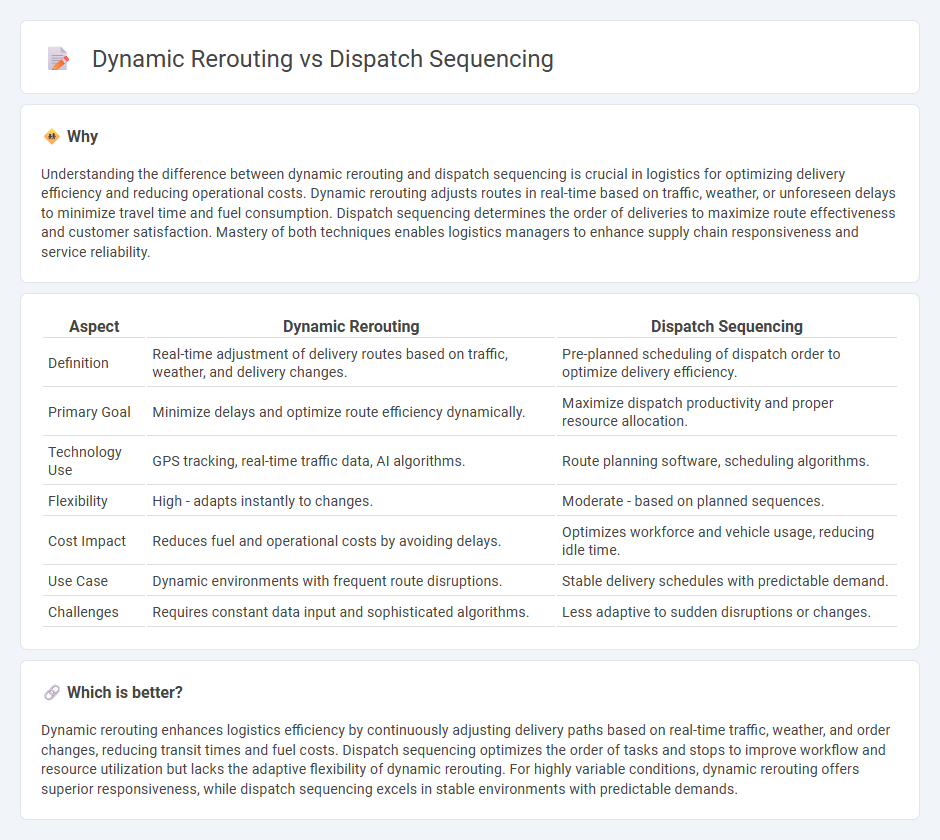
Dynamic rerouting enhances logistics efficiency by continuously adjusting delivery paths based on real-time traffic data and order changes, reducing delays and fuel costs. Dispatch sequencing optimizes the order of deliveries to maximize route efficiency and customer satisfaction by prioritizing time-sensitive or high-value shipments. Explore how integrating dynamic rerouting with dispatch sequencing can revolutionize your supply chain management.
Why it is important
Understanding the difference between dynamic rerouting and dispatch sequencing is crucial in logistics for optimizing delivery efficiency and reducing operational costs. Dynamic rerouting adjusts routes in real-time based on traffic, weather, or unforeseen delays to minimize travel time and fuel consumption. Dispatch sequencing determines the order of deliveries to maximize route effectiveness and customer satisfaction. Mastery of both techniques enables logistics managers to enhance supply chain responsiveness and service reliability.
Comparison Table
| Aspect | Dynamic Rerouting | Dispatch Sequencing |
|---|---|---|
| Definition | Real-time adjustment of delivery routes based on traffic, weather, and delivery changes. | Pre-planned scheduling of dispatch order to optimize delivery efficiency. |
| Primary Goal | Minimize delays and optimize route efficiency dynamically. | Maximize dispatch productivity and proper resource allocation. |
| Technology Use | GPS tracking, real-time traffic data, AI algorithms. | Route planning software, scheduling algorithms. |
| Flexibility | High - adapts instantly to changes. | Moderate - based on planned sequences. |
| Cost Impact | Reduces fuel and operational costs by avoiding delays. | Optimizes workforce and vehicle usage, reducing idle time. |
| Use Case | Dynamic environments with frequent route disruptions. | Stable delivery schedules with predictable demand. |
| Challenges | Requires constant data input and sophisticated algorithms. | Less adaptive to sudden disruptions or changes. |
Which is better?
Dynamic rerouting enhances logistics efficiency by continuously adjusting delivery paths based on real-time traffic, weather, and order changes, reducing transit times and fuel costs. Dispatch sequencing optimizes the order of tasks and stops to improve workflow and resource utilization but lacks the adaptive flexibility of dynamic rerouting. For highly variable conditions, dynamic rerouting offers superior responsiveness, while dispatch sequencing excels in stable environments with predictable demands.
Connection
Dynamic rerouting and dispatch sequencing are interconnected processes in logistics that optimize delivery efficiency and reduce operational costs. Dynamic rerouting adjusts delivery paths in real-time based on traffic, weather, or delivery priority changes, while dispatch sequencing organizes the order of deliveries to minimize travel time and fuel consumption. Together, these strategies enhance fleet utilization and improve customer satisfaction by ensuring timely, cost-effective shipments.
Key Terms
Route Optimization
Dispatch sequencing prioritizes the optimal order of deliveries to minimize travel time and fuel consumption, enhancing route efficiency. Dynamic rerouting adjusts routes in real-time based on traffic, delays, or new orders to maintain optimal delivery performance. Explore advanced route optimization strategies to boost logistics and operational efficiency.
Real-time Tracking
Dispatch sequencing enhances operational efficiency by organizing delivery tasks in a predetermined, optimized order based on factors like route distance and priority. Dynamic rerouting leverages real-time tracking data to adjust delivery paths instantly in response to traffic conditions, accidents, or delays, ensuring timely arrivals and reduced fuel consumption. Discover how integrating real-time tracking with advanced dispatch systems can revolutionize your logistics management.
Delivery Windows
Dispatch sequencing optimizes delivery routes by arranging stops in the most efficient order to meet predefined delivery windows, reducing wait times and enhancing customer satisfaction. Dynamic rerouting adjusts routes in real-time based on traffic, delays, or last-minute changes, ensuring deliveries stay within their time windows despite unforeseen disruptions. Explore how integrating both strategies can significantly improve delivery performance and adherence to tight schedules.
Source and External Links
5.3 Sequencing - Brown CS - Dispatch sequencing in this context refers to a dispatcher constructor that invokes a sequence of dispatchers one by one until one applies, handling requests in order and calling the next if the current dispatcher defers.
Dispatch Task Sequence - FlexSim - Dispatch sequencing involves dispatching task sequences to task executers at chosen times, allowing control over the order and timing of task execution in discrete event simulations.
Dispatch Buffering and Sequencing - Ocado Intelligent Automation - Dispatch sequencing here is about managing the order of outbound fulfillment processes by buffering and sequencing picked orders within automated storage systems to streamline high-throughput warehouse operations efficiently.
 dowidth.com
dowidth.com